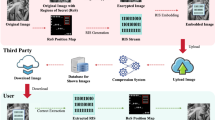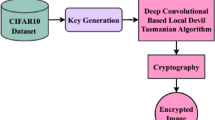Abstract
Images contain a wealth of information and are frequently targeted by malicious attackers when transmitted over public networks. Fortunately, image encryption prevents confidential information from being acquired by illegal attackers. Deep learning-based image encryption is a relatively new research area, but recently proposed methods have not achieved satisfactory levels of generalization, security, and efficiency. To address these limitations, we employ a lite dense residual network (Dense-ResNet) to rearrange image pixels, thereby reducing the computation amounts. In addition, we design a weight-adjustable loss function model, which combines the encryption loss function, decryption loss function, and total variational loss function. And then we adopt bit-XOR diffusion to further encrypt the intermedia ciphertext image obtained by the encryption network. We trained and tested encryption and decryption neural networks in a dataset of no fixed category images. Experiments declare our method can complete the image encryption/ decryption tasks in various scenarios. Additionally, the proposed approach exhibits broad generalization abilities with high encryption and decryption quality aided by the decryption total variation loss function. Compared to recently proposed deep learning-based image encryption approaches, our method demonstrates faster processing times for both image encryption and decryption, with at least a 2.7% and 7.5% increase in efficiency, respectively. Furthermore, our method improves decryption performance by at least 1.0% and 0.5% in Peak signal-to-ratio (PSNR) as well as structural similarity (SSIM) indicators while maintaining a high level of security. What is more, our method enhances traceability of data loss or noise attacks since such attacks leave a noticeable trail on decrypted images produced by our method.
















Similar content being viewed by others
Data availability
All the data required for this research work, i.e., BSDS500 and Div2k dataset, are available publicly on the Berkley University of California Computer vision group and Div2k website. The data can be accessed from http://www.eecs.berkeley.edu/Research/Projects/CS/vision/grouping/resources.html#bench and https://data.vision.ee.ethz.ch/cvl/DIV2K/
References
Agustsson E, Timofte R (2017) NTIRE 2017 challenge on single image super-resolution: dataset and study. In: In 2017 IEEE conference on computer vision and pattern recognition workshops (CVPRW). IEEE, Honolulu, USA. https://doi.org/10.1109/CVPRW.2017.150
Bao Z, Xue R (2021) Avalanche effect of image encryption based on the cycle-GAN. Appl Opt 60(18):5320–5334
Bao Z, Xue R, Jin Y (2021) Image scrambling adversarial autoencoder based on the asymmetric encryption. Multimed Tools Appl 80(18):28265–28301
Barik RC, Changder S (2020) A novel perceptual accessible image encryption scheme conjugating multiple chaotic maps. IET Image Process 14(11):2457–2468
Berkeley Computer Vision Group (2014) Contour detection and image segmentation resources. Available at http://www.eecs.berkeley.edu/Research/Projects/CS/vision/grouping/resources.html#bench, accessed March 2014
Chakraborty R, Verma G, Namasudra S (2021) IFODPSO-based multi-level image segmentation scheme aided with Masi entropy. J Ambient Intell Humaniz Comput 12:7793–7811
Chen G, Mao Y, Chui C (2004) A symmetric image encryption scheme based on 3D chaotic cat maps. Chaos, Solitons Fractals 21:749–761
Chen W, Guo Y, Guo S (2020) General image encryption algorithm based on deep learning compressed sensing and compound chaotic system. Acta Phys Sin 69(24):99–111. https://doi.org/10.7498/aps.69.20201019
Das S, Namasudra S (2022) Lightweight and efficient privacy-preserving mutual authentication scheme to secure internet of things-based smart healthcare. Trans Emerging Tel Tech https://doi.org/10.1002/ett.4716
Ding Y, Wu G, Chen D, Zhang N, Gong L, Cao M, Qin Z (2021) DeepEDN: a deep-learning-based image encryption and decryption network for internet of medical things. IEEE Internet Things J 8:1504–1518
Fang P, Liu H, Wu C, Liu M (2021) A secure chaotic block image encryption algorithm using generative adversarial networks and DNA sequence coding. Math Probl Eng 2021:6691547
Guo Y, Jing S, Zhou Y, Xu X, Wei L (2020) An image encryption algorithm based on logistic-Fibonacci cascade chaos and 3D bit scrambling. IEEE Access 8:9896–9912
He K, Zhang X, Ren S, Sun J (2016) Deep residual learning for image recognition. In: In 2016 IEEE conference on computer vision and pattern recognition (CVPR). IEEE, Las Vegas, USA, pp 770–778. https://doi.org/10.1109/CVPR.2016.90
Hua Z, Zhu Z, Yi S, Zhang Z, Huang H (2021) Cross-plane colour image encryption using a two-dimensional logistic tent modular map. Inf Sci 546:1063–1083
Huang G, Liu Z, Matten LVD, Weinberger KQ (2017) Densely connected convolutional networks. In: In 2017 IEEE conference on computer vision and pattern recognition (CVPR). IEEE, Honolulu, USA, pp 2261–2269. https://doi.org/10.1109/CVPR.2017.243
Huang H, Yang S, Ye R (2020) Efficient symmetric image encryption by using a novel 2D chaotic system. IET Image Process 14(6):1157–1163
Ioffe S, Szegedy C (2015) Batch normalization: accelerating deep network training by reducing internal covariate shift. In: The 32nd international conference on machine learning (ICML). JMLR, Lile, France, pp 448–456
Kang X, Guo Z (2020) A new color image encryption scheme based on DNA encoding and spatiotemporal chaotic system. Signal Process Image Commun 80:115670
Kang Y, Zhang L, Ye H, Zhang D, Zhuang S (2021) Ghost imaging-based optical cryptosystem for multiple images using integral property of the Fourier transform. Chin Phys B 30:124207
Kingma D, Ba J (2014) Adam: a method for stochastic optimization. arXiv. https://arxiv.org/pdf/1412.6980.pdf. Accessed 2021/10/1
Kumar P, Nishchal NK, AlFalou A (2022) Controllable optical vortex array for image encoding. IEEE Photon Technol Lett 34(10):521–524
Li S, Yu Y, Ji X, Sun Q (2021) A novel colour image encryption based on fractional order Lorenz system. Syst Sci Control Eng 9(S2):141–150
Li J, Zhou J, Di X (2021) A learning optical image encryption scheme based on CycleGAN. J Jilin Univ (Eng Technol Edition) 51(03):1060–1066. https://doi.org/10.13229/j.cnki.jdxbgxb20200521
Lin T, Wang X, Yang F, Xian Y (2021) Color image encryption based on cross 2D hyperchaotic map using combined cycle shift scrambling and selecting diffusion. Nonlin Dyn 105:1859–1876
Liu D, Huang X, Zhan W, Ai L, Zheng X, Cheng S (2021) View synthesis-based light field image compression using a generative adversarial network. Inf Sci 545:118–131
Liu H, Liu J, Ma C (2022) Constructing dynamic strong S-box using 3D chaotic map and application to image encryption. Multimed Tools Appl https://doi.org/10.1007/s11042-022-12069-x
Luan G, Zhong Z, Shan M (2021) Optical multiple-image encryption in discrete multiple-parameter fractional Fourier transform scheme using complex encoding, theta modulation and spectral fusion. Opt Appl LI(1):121–134
Maniyath SR, Thanikaiselvan V (2020) An efficient image encryption using deep neural network and chaotic map. Microprocess Microsyst 77:103134
Qian X, Yang Q, Li Q, Liu Q, Wu Y, Wang W (2021) A novel color image encryption algorithm based on three-dimensional chaotic maps and reconstruction techniques. IEEE Access 9:61334–61345
Shannon CE (1949) Communication theory of secrecy systems. Bell Syst Tech J 28:656–715
Ulyanov D, Vedaldi A, Lempitsky V (2016) Instance normalization: the missing ingredient for fast stylization. arXiv. http://arxiv.org/abs/1607.08022.pdf. Accessed 2021/10/1
Wang X, Yang J (2021) A privacy image encryption algorithm based on piecewise coupled map lattice with multi dynamic coupling coefficient. Inf Sci 569:217–240
Wang X, Zhang M (2021) An image encryption algorithm based on new chaos and diffusion values of a truth table. Inf Sci 579:128–149
Wang C, Zhang Y (2022) A novel image encryption algorithm with deep neural network. Signal Process 196:108536
Wani A, Revathi S, Khaliq R (2021) SDN-based intrusion detection system for IoT using deep learning classifier (IDSIoT-SDL). CAAI Trans Intell Technol 6(3):281–290
Yousif SF, Abboud AJ, Alhumaima RS (2022) A new image encryption based on bit replacing, chaos and DNA coding techniques. Multimed Tools Appl 81:27453–27493
Yu H, Li Y, Zhang J, Yang D, Ruan T, Wang H, Shi Y (2022) Optical image encryption scheme with extended visual cryptography and non-mechanical ptychographic encoding. J Opt 24:035702
Zhang Y, Wang X (2015) A new image encryption algorithm based on non-adjacent coupled map lattices. Appl Soft Comput 26:10–20
Zhang Y, Zuo F, Zhai Z (2011) Survey on image encryption based on chaos. Comput Eng Des (in Chinese) 32(02):463–466. https://doi.org/10.16208/j.issn1000-7024.2011.02.024
Zheng J, Liu L (2020) Novel image encryption by combining dynamic DNA sequence encryption and the improved 2D logistic sine map. IET Image Process 14(11):2310–2320
Zhou S, Wang X, Wang M, Zhang Y (2020) Simple colour image cryptosystem with very high level of security. Chaos, Solitons Fractals 141:110225
Zhou H, Xie H, Zhang H, Zhang H (2021) Parallel remote sensing image encryption algorithm based on chaotic map and DNA encoding. J Image Graph (in Chinese) 26(05):1081–1094. https://doi.org/10.11834/jig.200344
Zhu J, Park T, Isola P, Efros AA (2017) Unpaired image-to-image translation using cycle-consistent adversarial networks. In: In 2017 IEEE international conference on computer vision (ICCV). IEEE, Venice, Italy, pp 2242–2251. https://doi.org/10.1109/ICCV.2017.244
Acknowledgments
This study is supported by the Major Programs Incubation Plan of Xizang Minzu University “Research on multi-biometric characteristic image encryption method based on deep learning” under Grant 22MDZ03.
Author information
Authors and Affiliations
Corresponding author
Ethics declarations
Conflict of interest
The authors declare that they have no known competing financial interests or personal relationships that could have appeared to influence the work reported in this paper.
Additional information
Publisher’s note
Springer Nature remains neutral with regard to jurisdictional claims in published maps and institutional affiliations.
Rights and permissions
Springer Nature or its licensor (e.g. a society or other partner) holds exclusive rights to this article under a publishing agreement with the author(s) or other rightsholder(s); author self-archiving of the accepted manuscript version of this article is solely governed by the terms of such publishing agreement and applicable law.
About this article
Cite this article
Bao, Z., Xue, R., Hu, J. et al. Color image encryption based on lite dense-ResNet and bit-XOR diffusion. Multimed Tools Appl 83, 12819–12848 (2024). https://doi.org/10.1007/s11042-023-16073-7
Received:
Revised:
Accepted:
Published:
Issue Date:
DOI: https://doi.org/10.1007/s11042-023-16073-7





